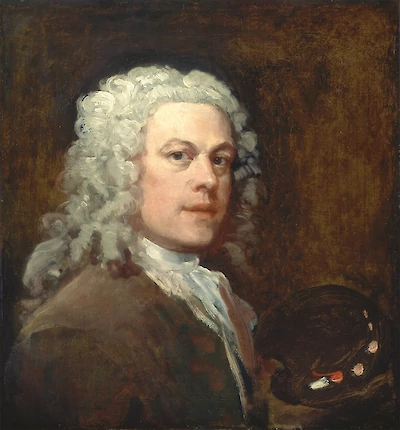

William Hogarth
A printmaker analyzes taste — and beauty comes out on top
1697 – 1764It may be remembered that in the introductory chapter the reader is desired to consider the surfaces of objects as so many shells of lines, closely connected together, which idea of them it will now be proper to call to mind, for the better comprehending not only this, but all the following chapters on composition.
The constant use made of lines by mathematicians, as well as painters, in describing things upon paper, has established a conception of them, as if actually existing on the real forms themselves. This, likewise, we suppose, and shall set out with saying in general — That the straight line, and the circular line, together with their different combinations, and variations, etc. bound, and circumscribe all visible objects whatsoever, thereby producing such endless variety of forms, as lays us under the necessity of dividing and distinguishing them into general classes; leaving the intervening mixtures of appearances to the reader’s own farther observation.
First, figure 1, plate 12, objects composed of straight lines only, as the cube, or of circular lines, as the sphere, or of both together, as cylinders and cones, etc.
Secondly, figure 2, plate 12, those composed of straight lines, circular lines, and of lines partly straight, and partly circular, as the capitals of columns, and vases, etc.
Thirdly, figure 3, plate 12, those composed of all the former together with an addition of the waving line, which is a line more productive of beauty than any of the former, as in flowers, and other forms of the ornamental kind; for which reason, we shall call it the line of beauty.
Fourthly, figure 4, plate 12, those composed of all the former together with the serpentine line, as the human form, which line has the power of super-adding grace to beauty. Note, forms of most grace have least of the straight line in them.
It is to be observed, that straight lines vary only in length, and therefore are least ornamental.
That curved lines, as they can be varied in their degrees of curvature, as well as in their lengths, begin, on that account, to be ornamental.
That straight and curved lines, joined, being a compound line, vary more than curves alone, and so become somewhat more ornamental.
That the waving line, or line of beauty, varying still more, being composed of two curves contrasted, becomes still more ornamental and pleasing, insomuch that the hand takes a lively movement in making it with pen or pencil.
And that the serpentine line, by its waving and winding at the same time different ways, leads the eye in a pleasing manner along the continuity of its variety, if I may be allowed the expression; and which, though but a single line, by its twisting so many different ways, may be said to enclose varied contents; and therefore all its variety cannot be expressed on paper by one continued line, without the assistance of the imagination, or the help of a figure; see figure 4, plate 12, where that sort of proportioned winding line, which will hereafter be called the precise serpentine line, or line of grace is represented by a fine wire properly twisted round the elegant and varied figure of a cone.